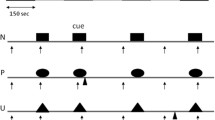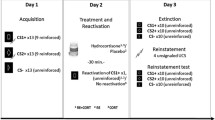Abstract
Rationale
Fear conditioning reliably increases the startle reflex and stress hormones, yet very little is known about the effect of stress hormones on fear-potentiated startle. Cortisol and the sulfate ester of dehydroepiandrosterone (DHEA-S) are involved in stress and anxiety. Evidence suggests that low cortisol/DHEA-S ratio has a buffering effect on stress and anxiety in preclinical and clinical studies, suggesting that there may be a relationship between fear-potentiated startle and cortisol and DHEA-S activity.
Objective
The aim of the study was to examine whether there is a relationship between cortisol/DHEA-S ratio and fear-potentiated startle.
Methods
Thirty healthy subjects participated in a differential aversive conditioning experiment during which one of two stimuli (CS+) was paired with a shock, and the other was not (CS−). Conditioned responses were assessed with the startle reflex, defined as startle potentiation during CS+ compared to CS−. DHEA-S and cortisol levels were assayed from blood samples collected in both a baseline and an aversive conditioning session. Subjective state anxiety, arousal, and valence were assessed at various times during testing.
Results
Fear-potentiated startle was larger in individuals with high compared to low cortisol/DHEA-S ratio. Multiple regression analyses revealed that fear-potentiated startle was positively associated with cortisol and negatively associated with DHEA-S. There was no significant correlation between DHEA-S and cortisol levels.
Conclusion
These data suggest that cortisol and DHEA-S are involved in fear conditioning.

Similar content being viewed by others
References
Abplanalp JM, Livingston L, Rose RM, Sandwisch D (1977) Cortisol and growth hormone responses to psychological stress during the menstrual cycle. Psychosom Med 39:158–177
Bernton E, Hoover D, Galloway R, Popp K (1995) Adaptation to chronic stress in military trainees. Adrenal androgens, testosterone, glucocorticoids, IGF-1, and immune function. Ann NY Acad Sci 774:217–231
Berridge CW, Dunn AJ (1986) Corticotropin-releasing factor elicits naloxone sensitive stress-like alterations in exploratory behavior in mice. Regul Pept 16:83–93
Blauer KL, Poth M, Rogers WM, Bernton EW (1991) Dehydroepiandrosterone antagonizes the suppressive effects of dexamethasone on lymphocyte proliferation. Endocrinology 129:3174–3179
Bradley M, Lang P (1994) Measuring emotion: the self-assessment manikin and the semantic differential. J Behav Ther Exp Psychiatry 25:49–59
Browne ES, Wright BE, Porter JR, Svec F (1992) Dehydroepiandrosterone: antiglucocorticoid action in mice. Am J Med Sci 303:366–371
Buchanan TW, Brechtel A, Sollers JJ, Lovallo WR (2001) Exogenous cortisol exerts effects on the startle reflex independent of emotional modulation. Pharmacol Biochem Behav 68:203–210
Campeau S, Falls WA, Cullinan WE, Helmreich DL, Davis M, Watson SJ (1997) Elicitation and reduction of fear: behavioural and neuroendocrine indices and brain induction of the immediate-early gene c-fos. Neuroscience 78:1087–1104
Clerici M, Trabattoni D, Piconi S, Fusi ML, Ruzzante S, Clerici C, Villa ML (1997) A possible role for the cortisol/anticortisols imbalance in the progression of human immunodeficiency virus. Psychoneuroendocrinology 22:S27–S31
Cole BJ, Koob GF (1988) Propranolol antagonizes the enhanced conditioned fear produced by corticotropin releasing factor. J Pharmacol Exp Ther 247:902–910
Coover GD, Ursin H, Levine S (1973) Plasma-corticosterone levels during active-avoidance learning in rats. J Comp Physiol Psychol 82:170–174
Corodimas KP, LeDoux JE, Gold PW, Schulkin J (1994) Corticosterone potentiation of conditioned fear in rats. Ann NY Acad Sci 746:392–393
Costa PT, McCrae RR (1985) The NEO personality inventory manual. Psychological Assessment Resources
Costa PT, McCrae RR (1992) Revised NEO Personality Inventory (NEO-PI-R) and NEO Five Factor Inventory (NEO-FFI) professional manual. Psychological Assessment Resources
Cruess DG, Antoni MH, Kumar M, Ironson G, McCabe P, Fernandez JB, Fletcher M, Schneiderman N (1999) Cognitive-behavioral stress management buffers decreases in dehydroepiandrosterone sulfate (DHEA-S) and increases in the cortisol/DHEA-S ratio and reduces mood disturbance and perceived stress among HIV-seropositive men. Psychoneuroendocrinology 24:537–549
Davis M (1997) The neurophysiological basis of acoustic startle modulation: research on fear motivation and sensory gating. In: Lang PJ, Simons RF, Balaban MT (eds) Attention and orientation: sensory and motivational processes. Lawrence Erlbaum Associates, Mahwah, New Jersey, pp 69–96
Davis M (1998) Are different parts of the extended amygdala involved in fear versus anxiety? Biol Psychiatry 44:1239–1247
Davis M, Falls WA, Campeau S, Kim M (1993) Fear-potentiated startle: a neural and pharmacological analysis. Behav Brain Res 58:175–198
Dickerson SS, Kemeny ME (2004) Acute stressors and cortisol responses: a theoretical integration and synthesis of laboratory research. Psychol Bull 130:355–391
Dubrovsky B (1997) Natural steroids counteracting some actions of putative depressogenic steroids on the central nervous system: potential therapeutic benefits. Med Hypotheses 49:51–55
Dunn AJ, File SE (1987) Corticotropin-releasing factor has an anxiogenic action in the social interaction test. Horm Behav 21:193–202
Dunn AJ, Elfvin KL, Berridge CW (1986) Changes in plasma corticosterone and cerebral biogenic amines and their catabolites during training and testing of mice in passive avoidance behavior. Behav Neural Biol 46:410–423
Fava M, Rosenbaum JF, MacLaughlin RA, Tesar GE, Pollack MH, Cohen LS, Hirsch M (1989) Dehydroepiandrosterone-sulfate/cortisol ratio in panic disorder. Psychiatry Res 28:345–350
First MB, Spitzer RI, Williams JBW, Gibbon M (1995) Structures Clinical Interview for DSM-V (SCID). American Psychiatric Association, Washington, DC
Fleshner M, Pugh CR, Tremblay D, Rudy JW (1997) DHEA-S selectively impairs contextual-fear conditioning: support for the antiglucocorticoid hypothesis. Behav Neurosci 111:512–517
Frye CA, Lacey EH (1999) The neurosteroids DHEA and DHEAS may influence cognitive performance by altering affective state. Physiol Behav 66:85–92
Goodyer IM, Herbert J, Altham PM, Pearson J, Secher SM, Shiers HM (1996) Adrenal secretion during major depression in 8- to 16-year-olds, I. Altered diurnal rhythms in salivary cortisol and dehydroepiandrosterone (DHEA) at presentation. Psychol Med 26:245–256
Goodyer IM, Herbert J, Altham PM (1998) Adrenal steroid secretion and major depression in 8- to 16-year-olds, III. Influence of cortisol/DHEA ratio at presentation on subsequent rates of disappointing life events and persistent major depression. Psychol Med 28:265–273
Grillon C, Baas JM (2003) A review of the modulation of startle by affective states and its application to psychiatry. Clin Neurophysiol 114:1557–1579
Hamm AO, Vaitl D, Lang PJ (1989) Fear conditioning, meaning, and belongingness: a selective association analysis. J Abnorm Psychology 98:395–406
Hechter O, Grossman A, Chatterton RT Jr (1997) Relationship of dehydroepiandrosterone and cortisol in disease. Med Hypotheses 49:85–91
Jovanovic T, Szilagyi S, Chakravorty S, Fiallos AM, Lewison BJ, Parwani A, Schwartz MP, Gonzenbach S, Rotrosen JP, Duncan EJ (2004) Menstrual cycle phase effects on prepulse inhibition of acoustic startle. Psychophysiology 41:401–406
Kalantaridou SN, Makrigiannakis A, Zoumakis E, Chrousos GP (2004) Stress and the female reproductive system. J Reprod Immunol 62:61–68
Kalimi M, Shafagoj Y, Loria R, Padgett D, Regelson W (1994) Anti-glucocorticoid effects of dehydroepiandrosterone (DHEA). Mol Cell Biochem 131:99–104
Kalin NH (1993) The neurobiology of fear. Sci Am 268:94–101
Kirschbaum C, Kudielka BM, Gaab J, Schommer NC, Hellhammer DH (1999) Impact of gender, menstrual cycle phase, and oral contraceptives on the activity of the hypothalamus–pituitary–adrenal axis. Psychosom Med 61:154–162
Korte SM (2001) Corticosteroids in relation to fear, anxiety and psychopathology. Neurosci Biobehav Rev 25:117–142
Kudielka BM, Schommer NC, Hellhammer DH, LKirschbaum C (2004) Acute HPA axis response, heart rate, and mood changes to psychosocial stress (TssT) in humans at different times of day. 29:283–292
Lee Y, Davis M (1997) Role of the hippocampus, the bed nucleus of the stria terminalis, and the amygdala in the excitatory effect of corticotropin-releasing hormone on the acoustic startle reflex. J Neurosci 17:6434–6446
Liang KC, Melia KR, Miserendino MJD, Falls WA, Campeau S, Davis M (1992) Corticotropin-releasing factor: long-lasting facilitation of the acoustic startle reflex. J Neurosci 12:2303–2312
Majewska MD (1992) Neurosteroids: endogenous bimodal modulators of the GABAA receptor. Mechanism of action and physiological significance. Prog Neurobiol 38:379–395
Makino S, Gold PW, Schulkin J (1994) Corticosterone effects on corticotropin-releasing hormone mRNA in the central nucleus of the amygdala and the parvocellular region of the paraventricular nucleus of the hypothalamus. Brain Res 640:105–112
Marinari KT, Leshner AI, Doyle MP (1976) Menstrual cycle status and adrenocortical reactivity to psychological stress. Psychoneuroendocrinology 1:213–218
Melchior CL, Ritzmann RF (1994) Dehydroepiandrosterone is an anxiolytic in mice on the plus maze. Pharmacol Biochem Behav 47:437–441
Michael A, Jenaway A, Paykel ES, Herbert J (2000) Altered salivary dehydroepiandrosterone levels in major depression in adults. Biol Psychiatry 48:989–995
Morgan CA III, Southwick S, Hazlett G, Rasmusson A, Hoyt G, Zimolo Z, Charney D (2004) Relationships among plasma dehydroepiandrosterone sulfate and cortisol levels, symptoms of dissociation, and objective performance in humans exposed to acute stress. Arch Gen Psychiatry 61:819–825
Prasad A, Imamura M, Prasad C (1997) Dehydroepiandrosterone decreases behavioral despair in high- but not low-anxiety rats. Physiol Behav 62:1053–1057
Rasmusson AM, Vasek J, Lipschitz DS, Vojvoda D, Mustone ME, Shi Q, Gudmundsen G, Morgan CA, Wolfe J, Charney DS (2004) An increased capacity for adrenal DHEA release is associated with decreased avoidance and negative mood symptoms in women with PTSD. Neuropsychopharmacology 29:1546–1557
Sanchez MM, Noble PM, Lyon CK, Plotsky PM, Davis M, Nemeroff CB, Winslow JT (2005) Alterations in diurnal cortisol rhythm and acoustic startle response in nonhuman primates with adverse rearing. Biol Psychiatry 57:373–381
Schulkin J, Gold PW, McEwens BS (1998) Induction of corticotropin-releasing hormones gene expression by glucocorticoids: implication for understanding the states of fear and anxiety and allostatic load. Psychoneuroendocrinology 23:219–243
Scott LV, Salahuddin F, Cooney J, Svec F, Dinan TG (1999) Differences in adrenal steroid profile in chronic fatigue syndrome, in depression and in health. J Affect Disord 54:129–137
Sunderland T, Merril CR, Harrington MG, Lawlor BA, Molchan SE, Martinez R, Murphy DL (1989) Reduced plasma dehydroepiandrosterone concentrations in Alzheimer's disease. Lancet 2:570
Swanson LW, Simmons DM (1989) Differential steroid hormone and neural influences on peptide mRNA levels in CRH cells of the paraventricular nucleus: a hybridization histochemical study in the rat. J Comp Neurol 285:413–435
Swerdlow NR, Geyer MA, Vale WW, Koob GF (1986) Cortico-releasing factor potentiates acoustic startle response in rats: blockade by chlordiazepoide. Psychopharmacology 88:147–152
Takahashi LK, Kalin NH, Vanden Burgt JA, Sherman JE (1989) Corticotropin-releasing factor modulates defensive-withdrawal and exploratory behavior in rats. Behav Neurosci 103:648–654
Tersman Z, Collins A, Eneroth P (1991) Cardiovascular responses to psychological and physiological stressors during the menstrual cycle. Psychosom Med 53:185–197
van Niekerk JK, Huppert FA, Herbert J (2001) Salivary cortisol and DHEA: association with measures of cognition and well-being in normal older men, and effects of three months of DHEA supplementation. Psychoneuroendocrinology 26:591–612
Vermeulen A (1980) Adrenal androgens and aging. In: Genezzani AR, Thijssen JHH, Siiteri PK (eds) Adrenal androgens. Raven, New York, pp 207–217
Wolf OT, Kirschbaum C (1999) Actions of dehydroepiandrosterone and its sulfate in the central nervous system: effects on cognition and emotion in animals and humans. Brain Res Brain Res Rev 30:264–288
Wolf OT, Kudielka BM, Hellhammer DH, Hellhammer J, Kirschbaum C (1998) Opposing effects of DHEA replacement in elderly subjects on declarative memory and attention after exposure to a laboratory stressor. Psychoneuroendocrinology 23:617–629
Zumoff B, Walsh BT, Katz JL, Levin J, Rosenfeld RS, Kream J, Weiner H (1983) Subnormal plasma dehydroisoandrosterone to cortisol ratio in anorexia nervosa: a second hormonal parameter of ontogenic regression. J Clin Endocrinol Metab 56:668–672
Acknowledgements
This research was supported by the Intramural Research Program of the National Institute of Mental Health.
Author information
Authors and Affiliations
Corresponding author
Rights and permissions
About this article
Cite this article
Grillon, C., Pine, D.S., Baas, J.M.P. et al. Cortisol and DHEA-S are associated with startle potentiation during aversive conditioning in humans. Psychopharmacology 186, 434–441 (2006). https://doi.org/10.1007/s00213-005-0124-2
Received:
Accepted:
Published:
Issue Date:
DOI: https://doi.org/10.1007/s00213-005-0124-2




